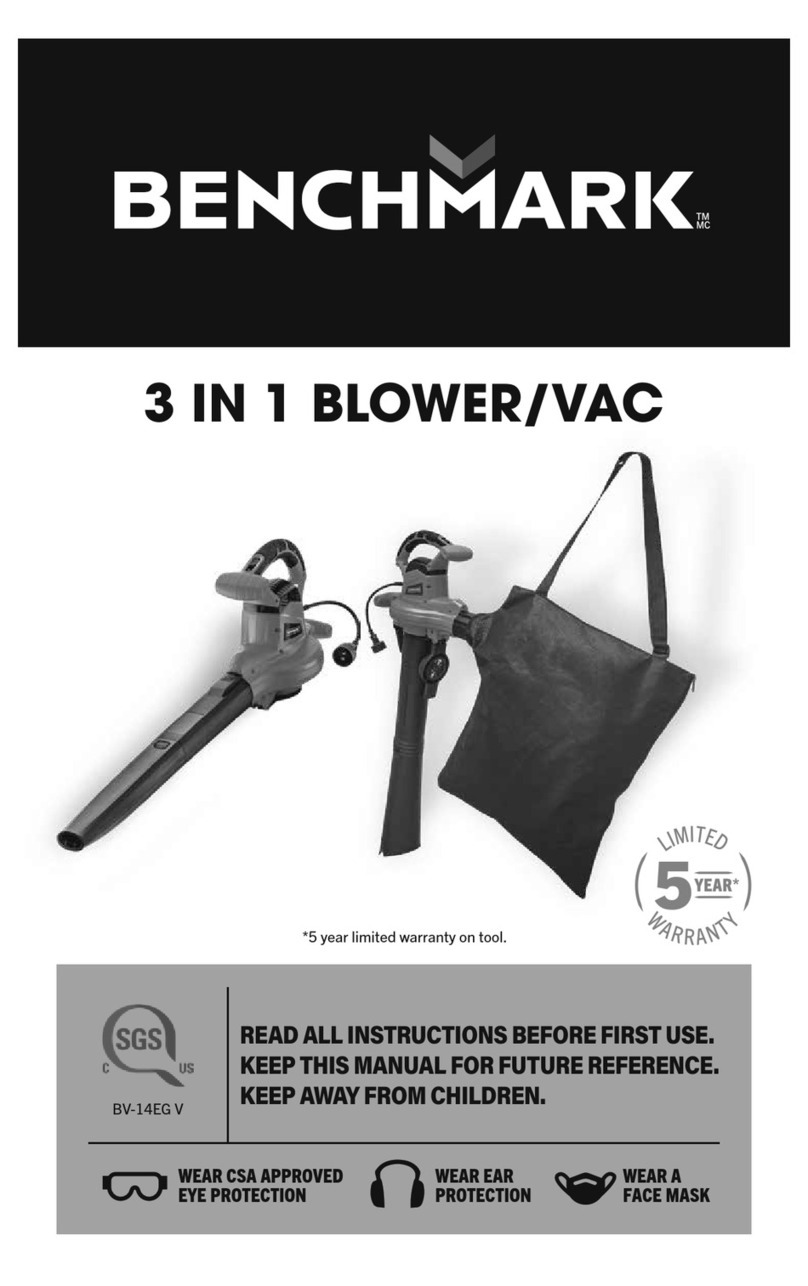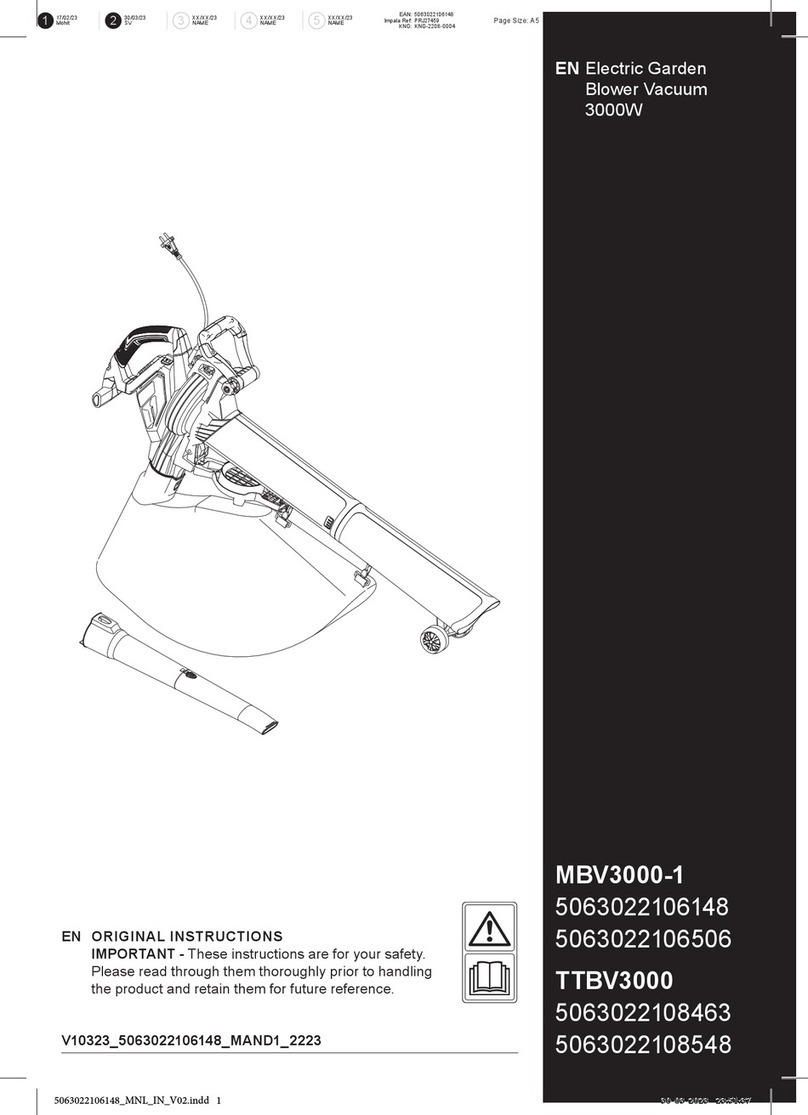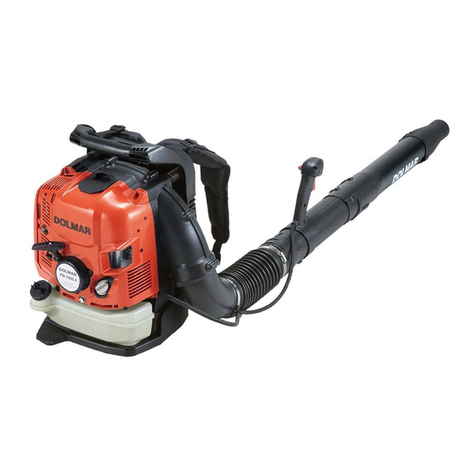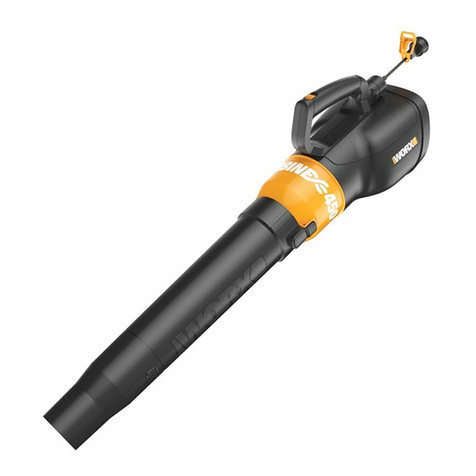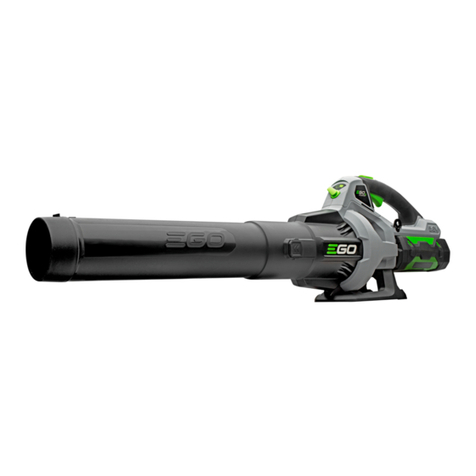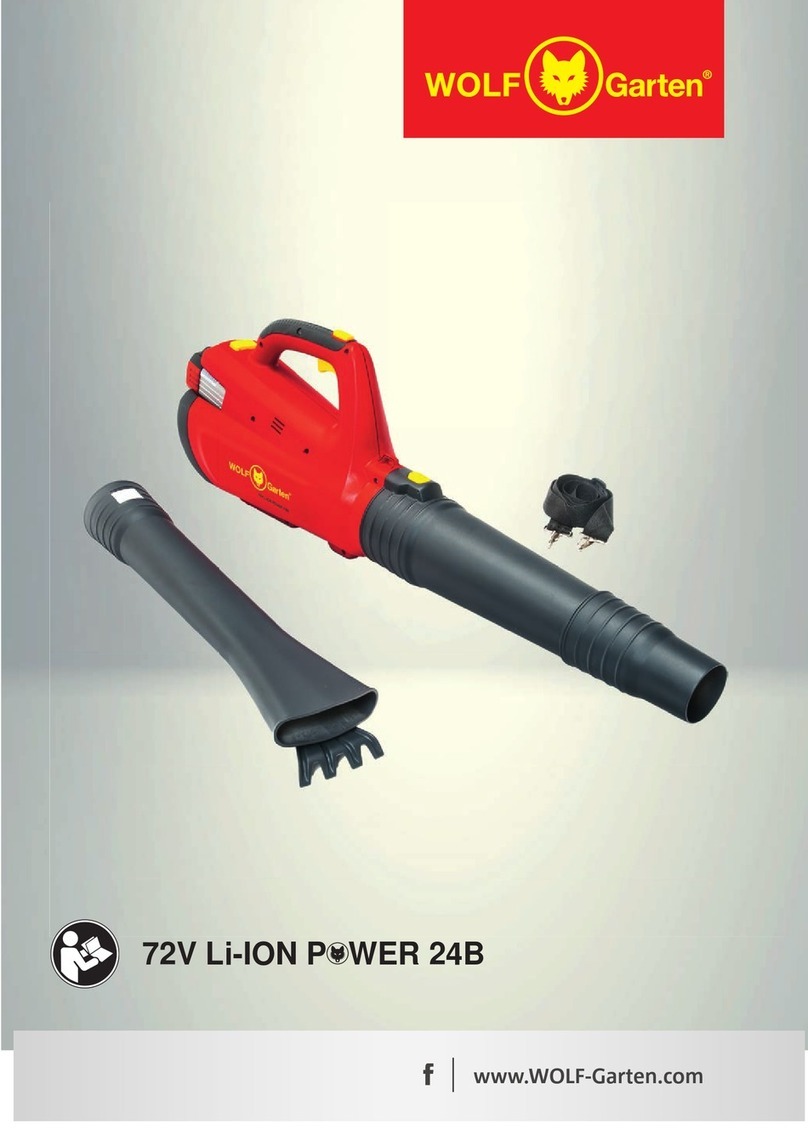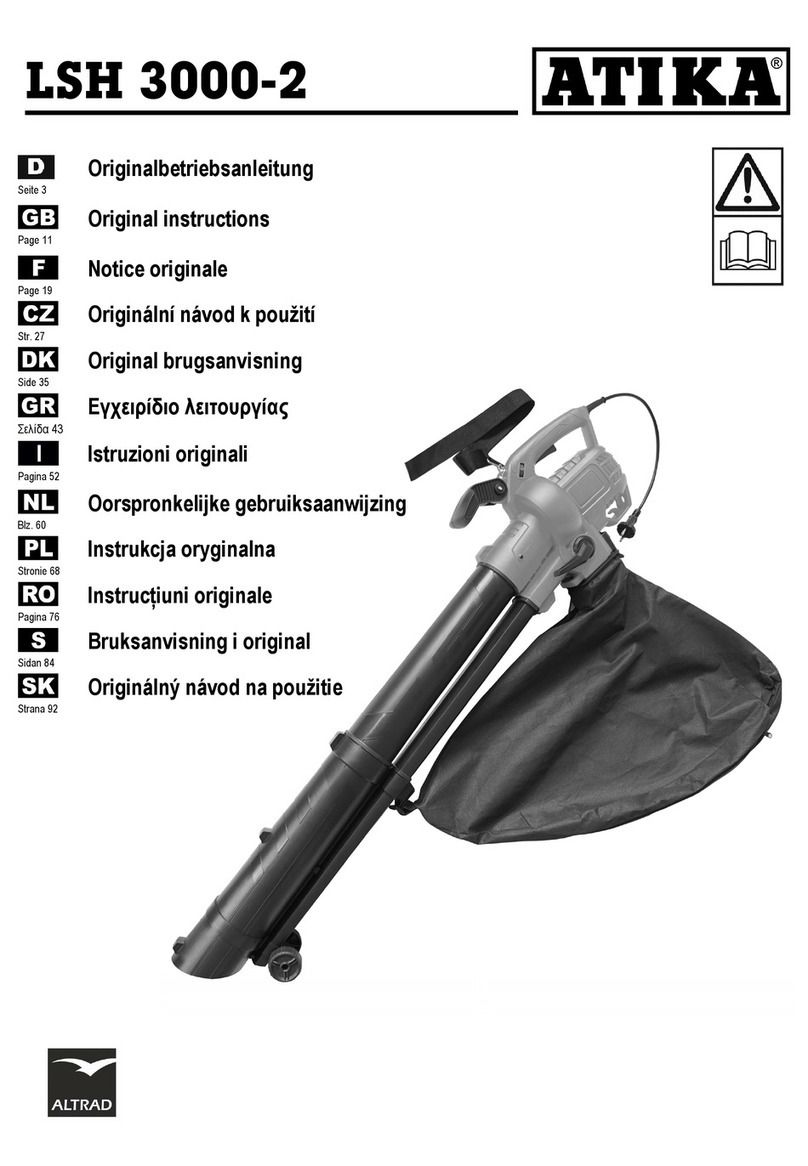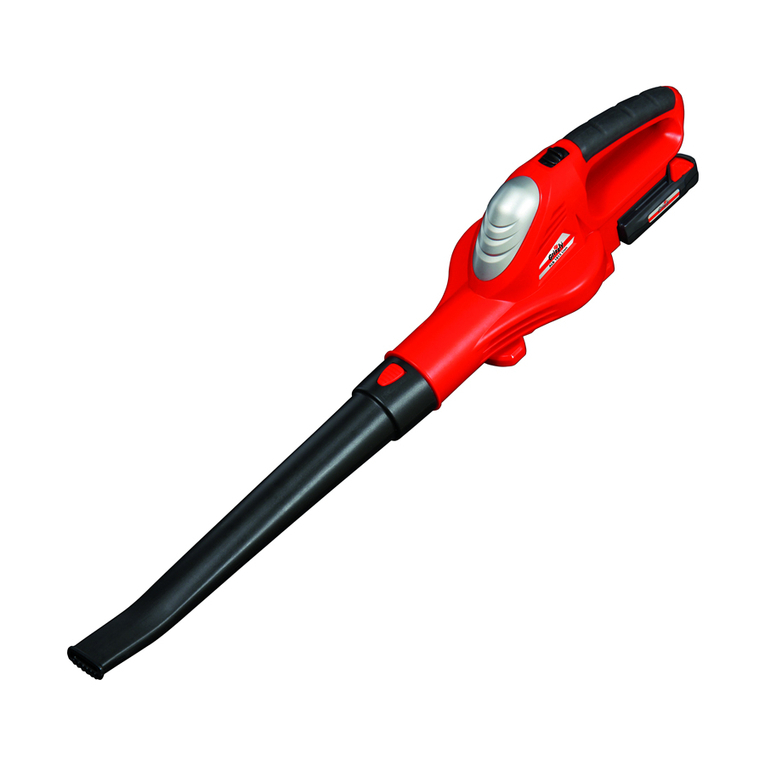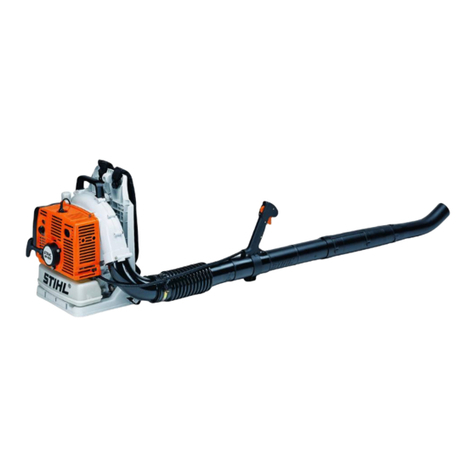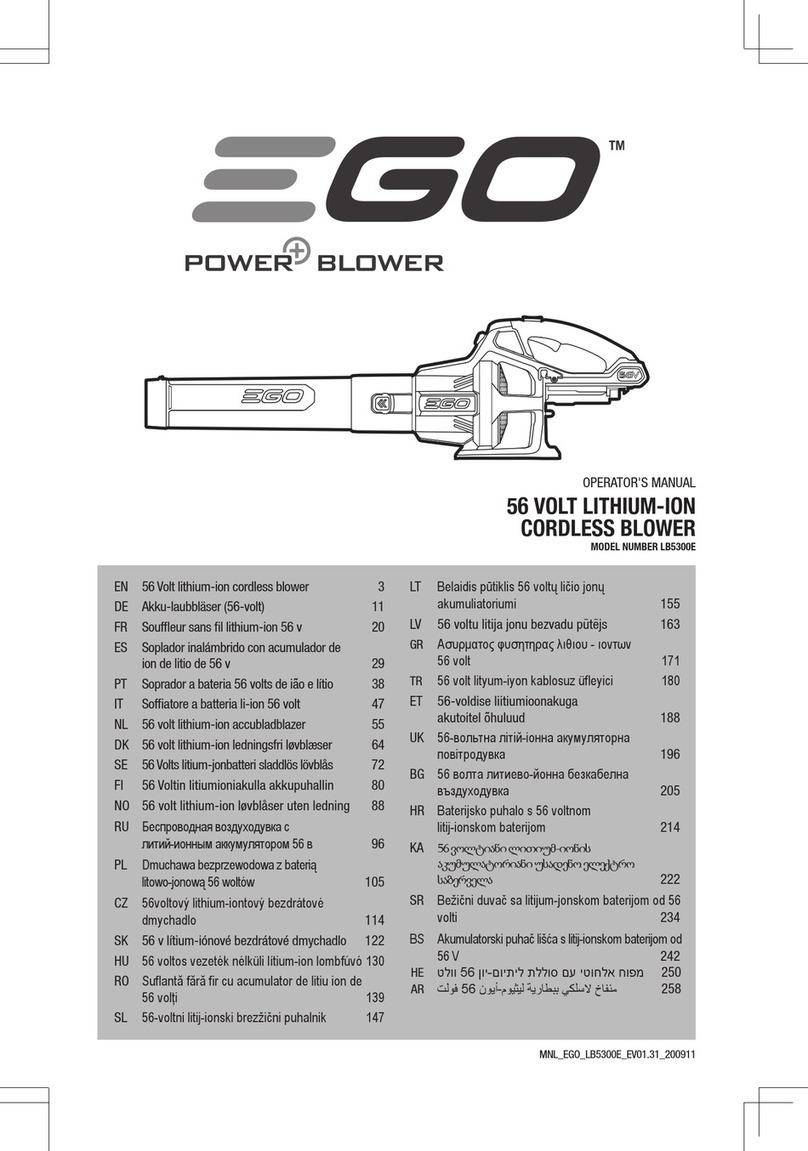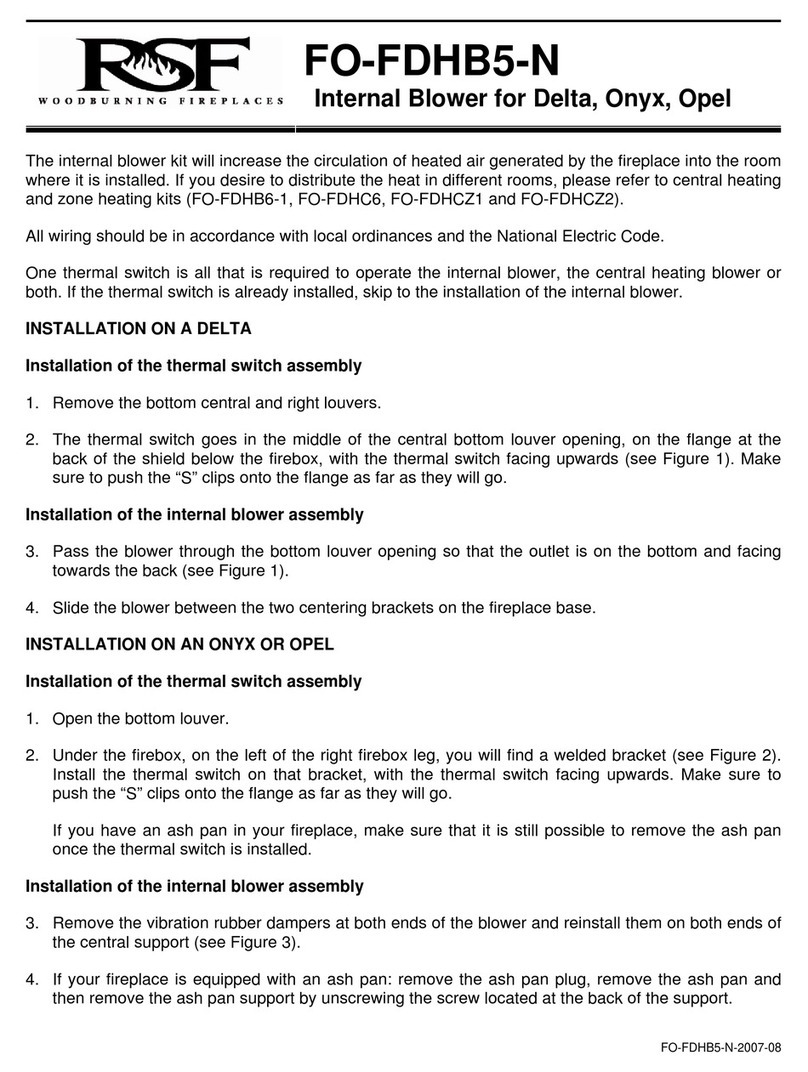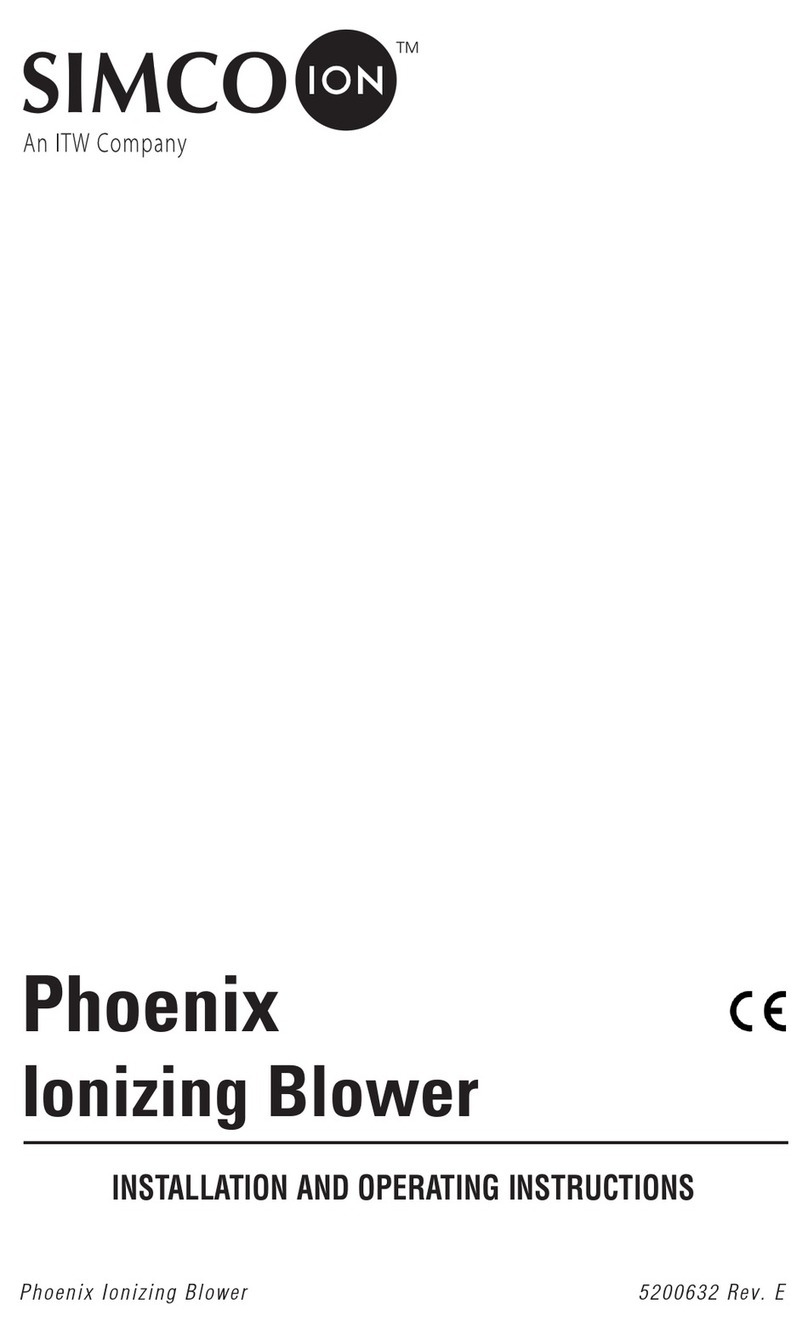Benchmark 5124-249 User manual

5124-249
READ ALL INSTRUCTIONS BEFORE FIRST USE.
KEEP THIS MANUAL FOR FUTURE REFERENCE.
KEEP AWAY FROM CHILDREN.
WEAR A
FACE MASK
WEAR EAR
PROTECTION
WEAR CSA APPROVED
EYE PROTECTION
120V • 60Hz • 13AMP
OWNER'S MANUAL
AXIAL FAN BLOWER
BV-15EG V

1
AXIAL FAN BLOWER - OWNER'S MANUAL
PRODUCT SPECIFICATIONS
Voltage: 120V~60Hz
Motor: 13 AMP
Air speed: 1st Speed – 85 MPH, 2nd Speed – 120 MPH
Air Volume: 1st Speed – 385 CFM, 2nd Speed – 550 CFM
Weight: 5.6 lbs (2.5kg)
Need Assistance?
Call us on our toll free customer support line:
1-866-349-8665 (Monday through Friday 9am – 5pm Eastern StandardTime)
• Technical questions
• Replacement parts
• Parts missing from package

2
5124-249
TABLE OF CONTENTS
Product specifications
Table of contents
General safety warnings
Specific safety rules
Extension cord safety
Safety symbols
Know your axial fan blower
Assembly
Operation
Maintenance
Troubleshooting
Exploded view
Parts list
Warranty
……….……………………………………………………………1
……….……………………………………………………………2
……….……………………………………………………………3-6
……….……………………………………………………………7-10
……….…………………………………………………………….11-12
……….……………………………………………………………13
……….…………………………………………………………….14
……….……………………………………………………………15
……….……………………………………………………………16
……………….…………………………………………………….17
……….……………………………………………………………18
……….……………………………………………………………19
……….……………………………………………………………20
……….……………………………………………………………21

3
AXIAL FAN BLOWER - OWNER'S MANUAL
GENERAL SAFETY WARNINGS
IMPORTANT SAFETY INSTRUCTIONS
Read and understand all safety and operational instructions. Failure to follow the safety
rules listed below and other basic safety precautions may result in
serious personal injury.
Keep this manual, sales receipts and applicable warranty
forms for future reference.
WARNING: Before using this tool or any of its accessories, read this manual and
follow all safety rules and operating instructions. The important precautions,
safeguards and instructions appearing in this manual are not meant to cover all
possible situations. It must be understood that common sense and caution are factors
which cannot be built into the product.
WEAR A
FACE MASK
WEAR EAR
PROTECTION
WEAR CSA APPROVED
EYE PROTECTION
EYE, EAR & LUNG PROTECTION
ALWAYS WEAR EYE PROTECTION THAT CONFORMS WITH CSA REQUIREMENTS
OR ANSI SAFETY STANDARD Z87.1
FLYING DEBRIS can cause permanent eye damage. Prescription eyeglasses ARE NOT a
replacement for proper eye protection.
WARNING: Noncompliant eyewear can cause serious injury if broken
during the operation of a power tool.
WARNING: Use hearing protection, particularly during extended periods
of operation of the tool, or if the operation is noisy.
WEAR A DUST MASK THAT IS DESIGNED TO BE USED WHEN OPERATING A
POWER TOOL IN A DUSTY ENVIRONMENT.
WARNING: Dust that is created by power sanding, sawing, grinding, drilling, and
other construction activities may contain chemicals that are known to cause cancer,
birth defects, or other genetic abnormalities.These chemicals include:
• Lead from lead-based paints.
• Crystalline silica from bricks, cement, and other masonry products.
• Arsenic and chromium from chemically treated lumber.
The level of risk from exposure to these chemicals varies, according to how often this type
of work is performed. In order to reduce exposure to these chemicals, work in a well-ventilated
area, and use approved safety equipment, such as a dust mask that is specifically designed
to filter out microscopic particles.

4
5124-249
WEAR A
FACE MASK
ELECTRICAL SAFETY
This tool is wired at the factory for 120V AC operation. It must be connected to a 120V AC,
15 AMP circuit that is protected by a time-delayed fuse or circuit breaker.To avoid shock
or fire, replace power cord immediately if it is worn, cut or damaged in any way.
WARNING: To avoid electrical hazards, fire hazards or damage to the tool, use
proper circuit protection.
WARNING: Read all safety warnings and instructions.
Failure to follow the
warnings and instructions may result in electric shock, fire and/or serious injury.
Save all warnings and instructions for future reference.
WORK AREA SAFETY
Keep work area clean and well lit. Cluttered or dark areas invite accidents.
Do not operate power tools in explosive atmospheres, such as in the presence
of flammable liquids, gases or dust. Power tools create sparks which may ignite the
dust or fumes.
Keep children and bystanders away while operating a power tool. Distractions
can cause you to lose control.
ELECTRICAL SAFETY
Power tool plugs must match the outlet. Never modify the plug in any way.
Do not use any adapter plugs with earthed (grounded) power tools. Unmodified
plugs and matching outlets will reduce risk of electric shock.
Avoid body contact with earthed or grounded surfaces such as pipes, radiators,
ranges and refrigerators. There is an increased risk of electric shock if your body is
earthed or grounded.
Do not expose power tools to rain or wet conditions. Water entering a power
tool will increase the risk of electric shock.
Do not abuse the cord. Never use the cord for carrying, pulling or unplugging
the power tool. Keep cord away from heat, oil, sharp edges or moving parts.
Damaged or entangled cords increase the risk of electric shock.
When operating a power tool outdoors, use an extension cord suitable for
outdoor use. Use of a cord suitable for outdoor use reduces the risk of electric
shock.

5
AXIAL FAN BLOWER - OWNER'S MANUAL
If operating a power tool in a damp location is unavoidable, use a residual current
device (RCD) protected supply. Use of a ground fault circuit interrupter (GFCI) reduces
the risk of electric shock.
PERSONAL SAFETY
Stay alert, watch what you are doing and use common sense when operating a
power tool. Do not use a power tool while you are tired or under the influence
of drugs, alcohol or medication. A moment of inattention while operating power
tools may result in serious personal injury.
Use personal protective equipment. Always wear eye protection. Protective
equipment such as dust mask, nonskid safety shoes, hard hat, or hearing protection used
for appropriate conditions will reduce personal injuries.
Prevent unintentional starting. Ensure the switch is in the off-position before
connecting to power source and/or battery pack, picking up or carrying the tool.
Carrying power tools with your finger on the switch or energizing power tools that have the
switch on invites accidents.
Remove any adjusting key or wrench before turning the power tool on. A
wrench or a key left attached to a rotating part of the power tool may result in personal
injury.
Do not overreach. Keep proper footing and balance at all times. This enables
better control of the power tool in unexpected situations.
Dress properly. Do not wear loose clothing or jewellery. Keep your hair,
clothing and gloves away from moving parts. Loose clothes, jewellery or long hair
can be caught in moving parts.
If devices are provided for the connection of dust extraction and collection
facilities, ensure these are connected and properly used. Use of dust collection
can reduce dust-related hazards.
POWER TOOL USE AND CARE
Do not force the power tool. Use the correct power tool for your application.
The correct power tool will do the job better and safer at the rate for which it was
designed.
Do not use the power tool if the switch does not turn it on and off. Any power
tool that cannot be controlled with the switch is dangerous and must be repaired.
Disconnect the plug from the power source and/or the battery pack from the
power tool before making any adjustments, changing accessories, or storing
power tools. Such preventive safety measures reduce the risk of starting the power tool
accidentally.

6
5124-249
Store idle power tools out of the reach of children and do not allow persons
unfamiliar with the power tool or these instructions to operate the power tool.
Power tools are dangerous in the hands of untrained users.
Maintain power tools. Check for misalignment or binding of moving parts,
breakage of parts and any other condition that may affect the power tool’s
operation. If damaged, have the power tool repaired before use. Many accidents are
caused by poorly maintained power tools.
Keep cutting tools sharp and clean. Properly maintained cutting tools with sharp
cutting edges are less likely to bind and are easier to control.
Use the power tool, accessories and tool bits etc. in accordance with these
instructions, taking into account the working conditions and the work to be
performed. Use of the power tool for operations different from those intended could
result in a hazardous situation.
Use auxiliary handles supplied with the tool. Loss of control can cause personal
injury.

7
AXIAL FAN BLOWER - OWNER'S MANUAL
SPECIFIC SAFETY RULES
WARNING: Some dust created by power sanding, sawing, grinding,
drilling,
and other construction activities contain chemicals known to cause cancer,
birth defects, or other reproductive harm. Some samples of these chemicals are:
lead from lead-based paints, crystalline silica from bricks and cement and other
masonry products, arsenic and chromium from chemically-treated lumber.
Your risk from these exposures varies, depending on how often you do this type of
work. To reduce your exposure to these chemicals: work in a well-ventilated area,
and work with approved safety equipment, such as those dust masks that are
specially designed to filter out microscopic particles.
WARNING: Know your axial fan blower. Do not plug in the tool until you have read
and understand this Instruction Manual. Learn the tool’s applications and limitations,
as well as the general and specific potential hazards related to this tool. Following these
instructions will reduce the risk of electric shock, fire or serious injury.
WARNING: Always wear appropriate eye protection. Any power tool can
throw foreign objects into your eyes and cause permanent eye damage. Always
wear appropriate safety goggles or properly fitted safety glasses that comply with
the
most recent version of ANSI Z87.1 safety standard. Ordinary vision or sunglasses
generally do not provide adequate impact or side shield / wrap around penetration
protection. Ordinary glasses ARE NOT safety glasses. To reduce the risk of injury to
your face you should also wear a face shield over your safety goggles or safety glasses.
WARNING: Glasses, goggles or face shields not in compliance with ANSI Z87.1
or CAN/CSA – Z94.3 could cause serious injury if they break upon impact.
WARNING: Prevent foot injuries! Never operate when barefoot, or wearing open
toed shoes, or sandals. Always, wear sturdy protective shoes or boots with nonslip
soles when operating the axial fan blower. Steel-toed safety boots are recommended.
WARNING: Protect your hands by wearing heavy-duty, nonslip gloves and to
improve your grip and control when handling the axial fan blower.
WARNING: Clothing must be durable and snug fitting yet allow for freedom
of movement.
WARNING: Avoid loose clothing such as scarves, neckties, jewellery, flared
or cuffed pants, loose-fitting shirts or jackets, unconfined long hair or anything
that can be pulled into the air intake of the blower. Secure hair to above shoulder
level. Wear long pants of durable material to protect your legs.
Cover as much of your body as possible to help protect you from debris and pieces
of toxic and allergenic plants being thrown by the axial fan blower.

8
5124-249
WARNING: Use hearing protection. Use hearing protection such as ear plugs
or ear mufflers to protect your hearing, particularly if the axial fan blower is
used for extensive periods or if the surrounding environment of operation exposes
the operator to loud noises. When wearing hearing protection, you will have impaired
ability to hear alarms, warnings and shouts from approaching people or approaching
vehicles. Be extra diligent and observant of hazards and bystanders when wearing
hearing protection devices. When someone approaches, turn the axial fan blower
OFF immediately.
WARNING: The high velocity of the air flow coming through the nozzle will
throw objects and debris violently. These objects and debris will ricochet in all
directions.
You or bystanders can be blinded or injured. Keep children, bystanders,
pets and other animals at least 50 feet (15 meters) away from the operating axial
fan
blower.Turn the axial fan blower OFF immediately if approached, or if you are
approaching such bystanders. Bystanders should be encouraged to wear eye protection,
even if they are kept at a distance.
WARNING: Thrown objects may also ricochet and strike the operator or bystander.
WARNING: Utilize extra caution, when the axial fan blower is being used near,
or on paved or hard surfaces, as pieces of metal, concrete, brick, stones, gravel,
sand, glass, sticks and other objects can be thrown at high speed and force and such
objects can be thrown, skip along or ricochet long distances off of hard surfaces.
WARNING: Do not use this axial fan blower for sweeping debris that may
contain hard objects, e.g. pebbles, stones, sticks, glass, metal, etc. As such
hard objects can be thrown with great force and cause injury to the operator or
bystanders,
and / or damage property, e.g., screens, windows, building siding, glass
doors, or vehicles.
WARNING: Avoid operating the axial fan blower near property that can be
easily damaged by thrown or ricocheting objects such as screens, windows,
building siding, glass doors and vehicles. Always wear breathing protection when
operating the tool. Bystanders should be encouraged to wear breathing protection
devices even if they are kept at a distance as hazardous dust can travel considerable
distances, especially if the dust is windblown.
WARNING: Know what you are going to blow, before you use your axial fan blower.
WARNING: Inspect the area to be cleared for hazards before each use. Remove
any foreign objects such as sticks, rocks, broken glass, nails, wire, tools, toys,
etc. which can be thrown by the axial fan blower.

9
AXIAL FAN BLOWER - OWNER'S MANUAL
WARNING: If you are suspicious or uncertain if the material that you are
considering blowing would cause hazardous dusts, first, identify and investigate
the nature of the materials. If the materials have the potential to be hazardous, do not
use the tool, instead, utilize other safe clean up procedures and disposal procedures.
If you are suspicious that you have been blowing or come into contact with asbestos,
or crystalline silica materials or hazardous chemical or biological materials, contact
your doctor, your employer if your use of the axial fan blower is job related, and the
local EPA or OSHA representative immediately. Clean up and dispose of hazardous
chemicals and substances prior to using the axial fan blower, using appropriate clean
up procedures, personal protective equipment and disposal methods.
WARNING: Dust created by use of this product may contain chemicals known
to
the State of California and medical experts to cause cancer, respiratory injuries, birth
defects or other reproductive harm. Some examples of these chemicals are: • Compounds in
fertilizers. • Compounds in insecticides, herbicides and pesticides. • Arsenic and chromium
from chemically treated lumber. • Commercial and household chemicals.
To reduce your exposure to these chemicals, wear approved safety equipment such as
dust and / or vapour masks that are specifically designed to filter out microscopic particles
or gaseous components. Additionally, dust created by this product may contain allergens,
bacteria and viruses, PM 10 and / or PM 2.5 particulates, exposure to such hazardous
airborne matter can be reduced by wearing approved safety equipment such as dust
masks that are specifically designed to filter out the microscopic particles.
WARNING: Breathing asbestos or dust with silica in its composition may contain
hazardous crystalline silica. Silica is a fundamental component of sand, quartz,
brick, clays, granite and many other materials and rocks, including masonry, concrete
and cement products. Such crystalline silica dust is dangerous and must be avoided,
as it can cause severe or fatal respiratory illness or cancer.
WARNING: Avoid axial fan blowing near open windows or doors, or anywhere
near bystanders or animals as doing such may cause exposure to the potentially
hazardous dust, particularly downwind of your blowing operation due to the respiratory
hazard reasons previously stated.
WARNING: Do not work against the wind as the dust will blow back towards the
operator increasing the exposure to the dust.
WARNING: Keep the axial fan blower below waist level and point the axial fan
blower nozzle below waist level.
WARNING: Check the axial fan blower screen before each use to make sure the
air intake screen and the fan are in good condition. If any damage is identified,
replace the part immediately before using the axial fan blower. A damaged fan may
shatter and a damaged air intake screen will allow your fingers to be injured by the fan.

10
5124-249
WARNING: Never operate the axial fan blower without the nozzle and
the intake fan screen in place. Serious injury or damage to the axial fan
blower may result.
WARNING: Never insert a foreign object such as a screwdriver, stick, etc. into
the nozzle, air exhaust tube or the intake fan screen. Any foreign article that
becomes lodged in the air system may be ejected at great speed causing serious
injury when the axial fan blower is turned ON. It may also severely damage the fan
of the axial fan blower.
WARNING: Always unplug the tool before making adjustments, changing the
nozzle, removing debris from the axial fan blower screen, leaving the tool idle
or unattended, cleaning, servicing, storing or transporting the tool. Such preventive
measures reduce the risk of starting the tool accidentally and causing serious injury.
WARNING: Never modify the axial fan blower in any way.The use of any other
accessory or modifying the tool may create a safety hazard.This action will also
void the warranty. Never use the axial fan blower without the nozzle properly installed.This
will allow you to direct the air flow where you want it and make the tool more efficient.
WARNING: Always keep the handles clean. Handles that are covered with grease,
chemicals or debris will make holding onto the axial fan blower difficult. Use a
clean cloth dampened with soapy water to clean these surfaces. Never use a pressure
washer, garden hose or any other liquid or chemical solvents to clean the axial fan blower.
WARNING: When blowing very dusty materials in extremely dry conditions for
long periods of time, static electricity may build up and discharge without warning.
To avoid this situation in dry dusty conditions, only operate the axial fan blower for
short periods of time and turning the axial fan blower OFF at regular intervals.
WARNING: Maintain firm footing and balance at all times. Do not overreach or
use the axial fan blower from unstable surfaces such as ladders, trees, steep
slopes, slippery surfaces, rooftops, etc. Always grasp the axial fan blower using the
handles on the machine. Use only in daylight or in good quality artificial light. Never
use the axial fan blower for anything other than its intended purpose. Use for anything
else can be dangerous. It may also damage the axial fan blower. Never walk backwards
while the axial fan blower is turned ON as you might trip and may not hear approaching
persons or vehicles.
SERVICE
Have your power tool serviced by a qualified repair person using only identical
replacement parts. This will ensure that the safety of the power tool is maintained.

11
AXIAL FAN BLOWER - OWNER'S MANUAL
WARNING: Keep the extension cord clear of the working area. Position the
cord so it will not get caught on the workpiece, tools or any other obstructions
while you are working with the power tool.
Make sure any extension cord used with this tool is in good condition. When using
an extension cord, be sure to use one of heavy enough gauge to carry the current
the tool will draw. An undersized cord will cause a drop in line voltage resulting in
loss of power and overheating.
The table below shows the correct size to use according to cord length and nameplate
ampere rating. If in doubt, use the next heavier gauge.The smaller the gauge number
the heavier the cord.
Be sure your extension cord is properly wired and in good condition. Always replace
a damaged extension cord or have it repaired by a qualified electrician before using
it. Protect your extension cord from sharp objects, excessive heat and damp or wet
areas.
Use a separate electrical circuit for your power tools. This circuit must not be less
than 14 gauge wire and should be protected with either a 15 AMP time delayed fuse
or circuit breaker. Before connecting the power tool to the power source, make sure
the switch is in the OFF position and the power source is the same as indicated on
the nameplate. Running at lower voltage will damage the motor.
To reduce the risk of disconnection of axial fan blower cord from the extension cord
during operating: Make a knot as shown in Fig. 1.
Fig. 1
(B) Connect plug and receptacle
(A) Tie cord as shown
CORD
SET
APPLIANCE
CORD
EXTENSION CORD SAFETY

12
5124-249
Use one of the plug – Receptacle retaining straps or connectors described in
this guide.
Avoid unintentional starting – Don’t carry plugged in axial fan blower with finger
on On/Off switch. Be sure switch is off when plugging in.
Handle cord carefully – Never carry axial fan blower by cord or yank it to
disconnect from power source. Keep cord away from heat, oil, and sharp edges.
Don’t force axial fan blower – It will do the job better and with less likelihood
of a risk of injury at the rate for which it was designed.
Don’t Overreach – Keep proper footing and balance at all times.
Stay Alert – Watch what you are doing. Use common sense. Do not operate tool
when you are tired or under the influence of alcohol, drugs or medications that cause
drowsiness.
Disconnect axial fan blower – Disconnect the axial fan blower from the power
supply when not in use, before servicing, when changing accessories such as axial
fan blower tubes.
Keep guards in place and in working order.
Keep hands and feet away from blowing area.

13
AXIAL FAN BLOWER - OWNER'S MANUAL
BV-15EG V
This symbol designates that this tool is listed with Canadian
and U.S. requirements by cTUVus Testing Laboratories, Inc.
UL1017 CSA C22.2 No.243-17
SAFETY SYMBOLS
WARNING: Please read all of the safety and operating instructions
carefully before using this tool. Please pay particular attention to all
sections of this User Guide that carry warning symbols and notices.
Some of the following symbols may be used on this tool.
Observe caution and safety notes.
To reduce the risk of injury, user must read and understand User Guide before
using this tool.
Wear ear protection.
Wear protective helmet and eye protection.
Switch off and remove plug from power source before cleaning or maintenance.
Do not use in the rain or leave outdoors while it is raining.
Keep bystanders away.
Don’t touch the inlet and outlet when the vacuum cover is opened or the tube
is removed.
Double insulation.
Remove plug from the power source immediately if the power cord is damaged
or cut.

14
5124-249
KNOW YOUR AXIAL FAN BLOWER
Handle
Two speed / Off switch
Cord retainer
Axial fan blower outlet
Axial fan
blower tube
Nozzle release
buttons

15
AXIAL FAN BLOWER - OWNER'S MANUAL
ASSEMBLY
ASSEMBLE & INSTALL NOZZLE
Install the nozzle assembly to the axial fan blower as follows:
1. Slide the large end of the rear nozzle section (1) over the axial fan blower intake
(2) (Fig. 3).
2. Push the rear nozzle section firmly on to the axial fan blower intake until the nozzle
release button (3) “clicks” into place locking the nozzle assembly onto the axial fan
blower intake.
SWITCH ON
Point the blower tube downwards when operating the device.We recommend running
the electrical cord towards the rear over your shoulder.
Move switch to position (1), for minimum speed (fig. 4).
Move switch to position (2), for maximum speed (fig. 5).
1
Fig. 3
23
Fig. 4 Fig. 5
12

16
5124-249
OPERATION
OPERATING THE AXIAL FAN BLOWER
WARNING: For safety reasons, the operator must read the sections of this
Owner’s
Manual entitled general safety warnings, specific safety rules and
symbols before
using this axial fan blower.
Verify the following every time the axial fan blower is used:
1. Safety glasses or goggles, hearing protection and all required safety clothing
are being worn.
2.The area of operation is cleared of all dangerous debris such as broken glass and
free of materials that could derive hazardous dust.
3. Bystanders are at least 50' (15 m) away from the operation area.
Failure to observe these safety rules will significantly increase the risk of injury.
The axial fan blower is well balanced and is designed to be used with one hand (Fig. 6).
WARNING: Always wear appropriate personal protective equipment.
Operate the axial fan blower below your waist height at all times.The most effective
position for blowing is to hold the axial fan blower at an angle of less than 45° to the
ground and with the nozzle close to the ground. Using a side to side sweeping motion
will make clearing large areas easier.
Fig. 6

17
AXIAL FAN BLOWER - OWNER'S MANUAL
MAINTENANCE
WARNING: When servicing, use only identical replacement parts. Use of any
other parts may create a hazard or cause product damage.
WARNING: Always wear protective gloves during maintenance operations. Do
not carry out maintenance when the engine is running or hot.
Avoid using solvents when cleaning plastic parts. Most plastics are susceptible to
damage from various types of commercial solvents and may be damaged by their
use. Use clean cloths to remove dirt, dust, oil, grease, etc.
WARNING: Do not at any time let brake fluids, gasoline, petroleum based products,
penetrating oils, etc., come in contact with plastic parts. Chemicals can damage,
weaken or destroy plastic which may result in serious personal injury.
STORAGE
Clean all foreign material from the axial fan blower.
Store indoors in a place that is inaccessible to children. Keep away from corrosive
agents such as garden chemicals and deicing salts.

18
5124-249
TROUBLESHOOTING
WARNING: Read User Guide first! Follow all safety precautions whenever
diagnosing or servicing the tool. Disconnect power supply before service.
Problem
Tool will not start.
Tool will not blow.
Tool’s On/Off switch is in the
Off position.
Possible Cause Fault Correction
Check whether the On/Off
switch is in the On position.
Cord not connected. Check that cord is plugged in.
No power at outlet.
Defective power cord.
Internal damage or wear.
Check power at outlet. If
outlet is unpowered, turn off
tool and check circuit breaker.
If breaker is tripped, make
sure circuit is right capacity
for tool and circuit has no
other loads.
Replace the cord.
Please contact Toll Free Help Line
at 1-866-349-8665; Mon. - Fri.: 9
am - 5 pm EST.
NOTE: If the tool vibrates, please immediately stop using it. Please call the Toll Free
Help Line at 1-866-349-8665; Monday - Friday: 9 am to 5 pm Eastern Standard Time.

19
AXIAL FAN BLOWER - OWNER'S MANUAL
EXPLODED VIEW
Table of contents
Other Benchmark Blower manuals
